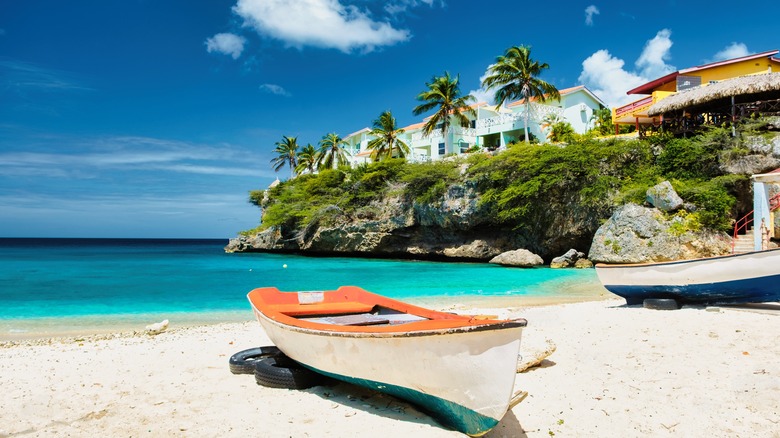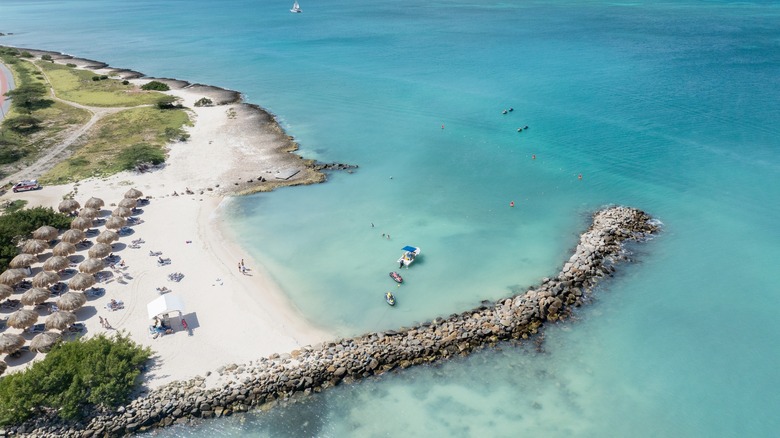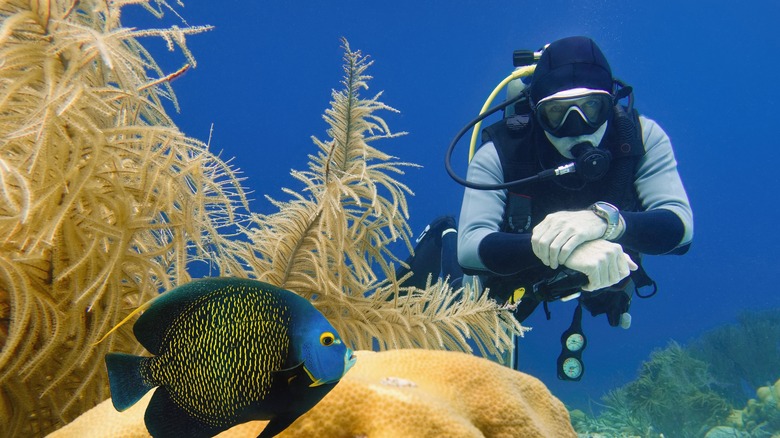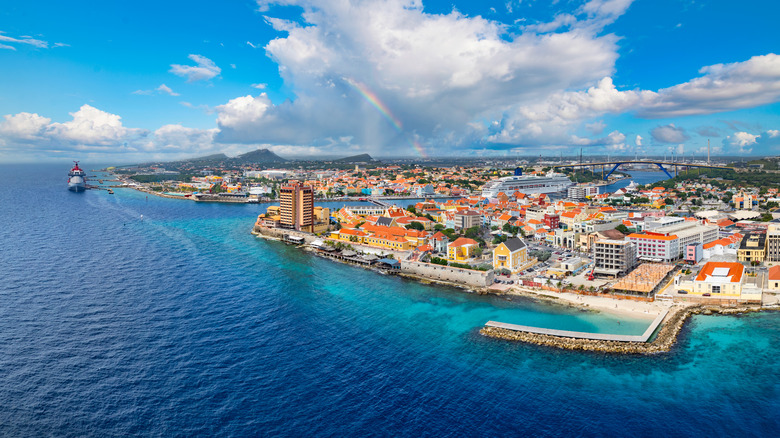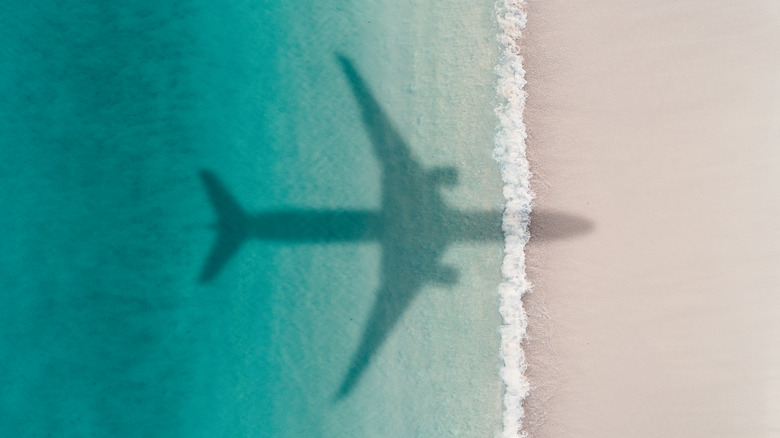The Caribbean's 'ABC' Islands Offer Pristine Beaches Outside The Notorious Hurricane Belt
When it comes to exotic vacation locales, the Caribbean is one of the most popular options in the world for a good reason. The whole area is dotted with islands, each with white sand beaches, gorgeous scenery, and incredible weather. In fact, if you're trying to find which of the best beaches in the Caribbean to visit, it can seem a bit overwhelming. But all you really have to do is to remember the alphabet.
For the uninitiated, the Caribbean is home to the "ABC Islands," which are some of the most beautiful and accommodating spots for travelers. The acronym stands for Aruba, Bonaire, and Curacao –– and each island has its own unique spin on tropical paradise. But why these islands? Well, they're the westernmost spots of the Leeward Antilles Islands, they share a common language and heritage, and they're just outside the Caribbean's disastrous hurricane belt.
Even if you've never heard of these islands before, rest assured that they're incredibly welcoming and offer some of the best travel experiences in the region. So, if you're trying to figure out where you're going on your next tropical vacation, let's get to know our ABCs.
Aruba
Let's kick things off with the first island on the list that also happens to be the most famous, at least if the Beach Boys are to be believed. Aruba is also the safest Caribbean island in 2025, making it an inviting destination for all travelers. Not only is the island fairly safe from crime, but it's also well outside the Hurricane Belt, so you almost never have to worry about planning around inclement weather. Generally, Aruba has a hot and dry climate with temperatures in the 80s practically year-round. The summers, however, can get pretty muggy and humid, although trade winds can help you beat the heat.
When it comes to beaches, the entire island is covered in white sand, but some spots are much better than others. Most of the infrastructure, including the capital city, is on the western side of the island, so the eastern half is much more rugged and undeveloped. So, if you're feeling adventurous, you might want to try uncrowded beaches like Andicuri Beach, Daimari Beach, or Dos Playa. However, if you prefer to be closer to the action and want endlessly walkable beaches, you can check out Eagle Beach or Divi Beach, which are next to all kinds of shopping and dining options.
Aruba's cuisine is a mixture of native Caribbean, Spanish, and Dutch, giving the island a unique flavor. If you want to eat and drink like a local, try dishes like pastechi or stoba di caprito (goat stew). You can also get a side of history by eating in a historical restaurant, such as the Old Cunucu House, the De Olde Molen (Dutch for the Old Mill), or Restaurant Anno 1877. The Old Mill is perfect if you want to learn more about Dutch colonization and culture on the island.
Bonaire
When looking at the map and moving left to right, the next island in this chain is actually Curacao. However, since we're going alphabetically, we'll focus our attention on the world's first designated "blue destination," Bonaire. We're still in the Dutch Caribbean, so there are similar vibes to Aruba, but Bonaire is much less developed. A big reason why the island is so renowned is that it's perfect for nature lovers who want a pristine tropical vacation experience. Aruba is for the tourists who want a taste of home while they're away, but Bonaire is for the adventurers and explorers.
While relaxing on the beach and listening to the waves is certainly one thing to do on this island, you also should venture out to see the local wildlife and scenery as much as possible. Snorkeling is a popular activity, and one of the best snorkeling spots is Klein Bonaire, an uninhabited island just off the coast of the island's capital. Because the island is a nature preserve, you can see all kinds of fish and sea life in the coral reefs just below the surface. Other top-tier snorkeling options include 1,000 beaches and Lac Bay, but there are many spots to explore around the island.
As with Aruba, Bonaire's climate is hot and arid, with the summer months bringing most of the humidity. Peak season for visiting this island is usually between December to April, which is outside of hurricane season and relatively cool. However, the number of tourists are surprisingly few, especially when compared to the other islands. For example, while Aruba welcomes about 2 million visitors annually, Bonaire doesn't even get a tenth of that (around 180,000 in 2024).
Curacao
Last, but certainly not least, is the island of Curacao. Like Aruba, this island is well-developed and caters to tourists from around the world, including nearby Venezuela. As the largest of the three islands, there's more to see and do here –– so you should plan your vacation accordingly. When it comes to beaches, Curacao has about 37 options, including Playa Porto Mari, one of the island's most famous beaches with endless turquoise water beauty. With so many unique beaches to choose from, you don't have to worry about fighting through crowds. If one beach has too many people, just head over to the next one.
Most of the island's infrastructure is centered around its capital, Willemstad, but the rest of the island is relatively remote and undeveloped. In the north, you can explore natural sites like the Christoffel National Park, which is also the largest national park on the island. Here, you can climb the mountain, see all kinds of local wildlife, or take a guided safari tour. If you prefer water sports, the southern part of the island, around Caracas Bay, is perfect for renting boats and watercraft to experience the crystal blue waters.
For food, one of the best spots is the Old Market, aka the Marché Bieu. Here, you can buy "krioyo" dishes from local vendors. Krioyo is a style of cooking native to the ABC Islands, and it's full of fresh flavors and unique spices. For a truly one-of-a-kind experience, head to the Netto Bar, which is Curacao's oldest bar and the only place where you can drink and buy green rum.
Tips and tricks for visiting the ABC Islands
If you're going to the ABC Islands from the United States, the experience is much different than other, more U.S.-friendly options like the Bahamas or Puerto Rico. While English is commonly spoken on these islands, they cater to more of a European crowd, so it's best to learn some local words and phrases to help you get around. That said, American currency is widely accepted across all three islands, so you don't necessarily have to exchange your dollar bills for local ones. Bonaire only uses U.S. money, while Aruba and Curacao each have their own currency, which cannot be used interchangeably between islands (so you would have to exchange your currency depending on which island you're on).
Since the ABC Islands are relatively close to each other and all part of the Dutch Caribbean, it's easy to fly between them if you want the ultimate exotic vacation. If you stick to the bigger cities and resort areas, getting around is a breeze. However, if you want to explore more of the remote parts of each island, you'll need to rent a car. Fortunately, they drive on the right side of the road on all three islands, so you don't have to re-learn how to operate a vehicle during your visit.
Finally, being outside of the Hurricane Belt means you can pick any time of year to vacation on the ABC Islands. As we mentioned, December through April are typically peak travel seasons because the weather isn't as hot and muggy as it is during the summer. That said, Curacao and Aruba can get pretty crowded in the big cities regardless of the time of year because they're common stopovers for cruise ships. To really avoid crowds, Bonaire is the best bet.
